Simple Microscope is a scientific instrument used to magnify microscopic objects so that they are visible to the unaided eye. It is a double convex lens with a short focal length that is mounted in a lens holder.
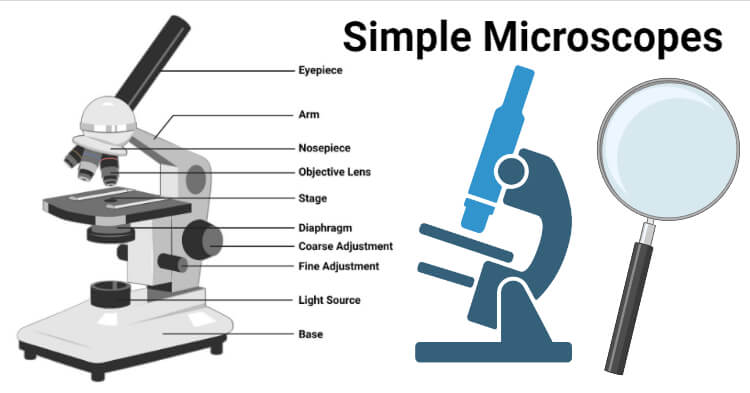
This lens is a single, high-powered converging lens that produces virtual images by magnification which cannot be projected on a screen like real image. The first simple microscope was created by Dutch scientist Antonie Van Leeuwenhoek to examine the tiny microorganisms in freshwater.
A reading or magnifying glass is the most well-known example from today.
Interesting Science Videos
Principle of Simple Microscope
The light from the light source travels through the glass slide holding the sample after reflection of the light from the mirror when it is set up on the stage. The biconvex lens used in the microscope enlarges the image of the object to offer a clear, magnified image for viewing the microscopic details of the sample. The image is then seen from the opposite side.
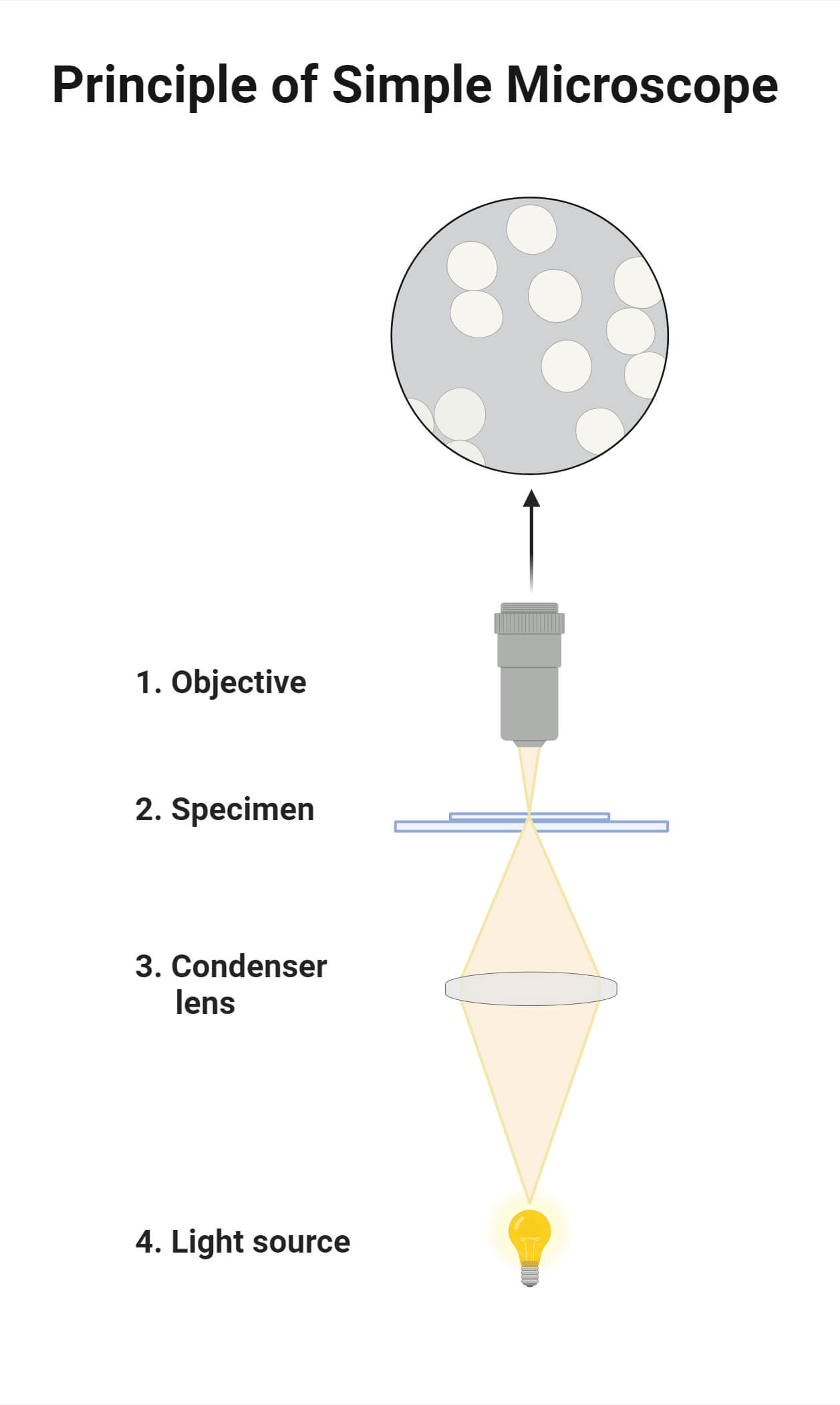
Magnification of Simple Microscope
Simple microscopes have the magnification power which is given by:
M = 1 + D/f
where, M = Magnification power of simple microscope.
D = Least distance of distinct vision, generally 25cm for a normal human eye.
f = Focal length of the convex lens.
From the above expression, it can be deduced that shorter the focal length of the lens, higher will be its magnification power.
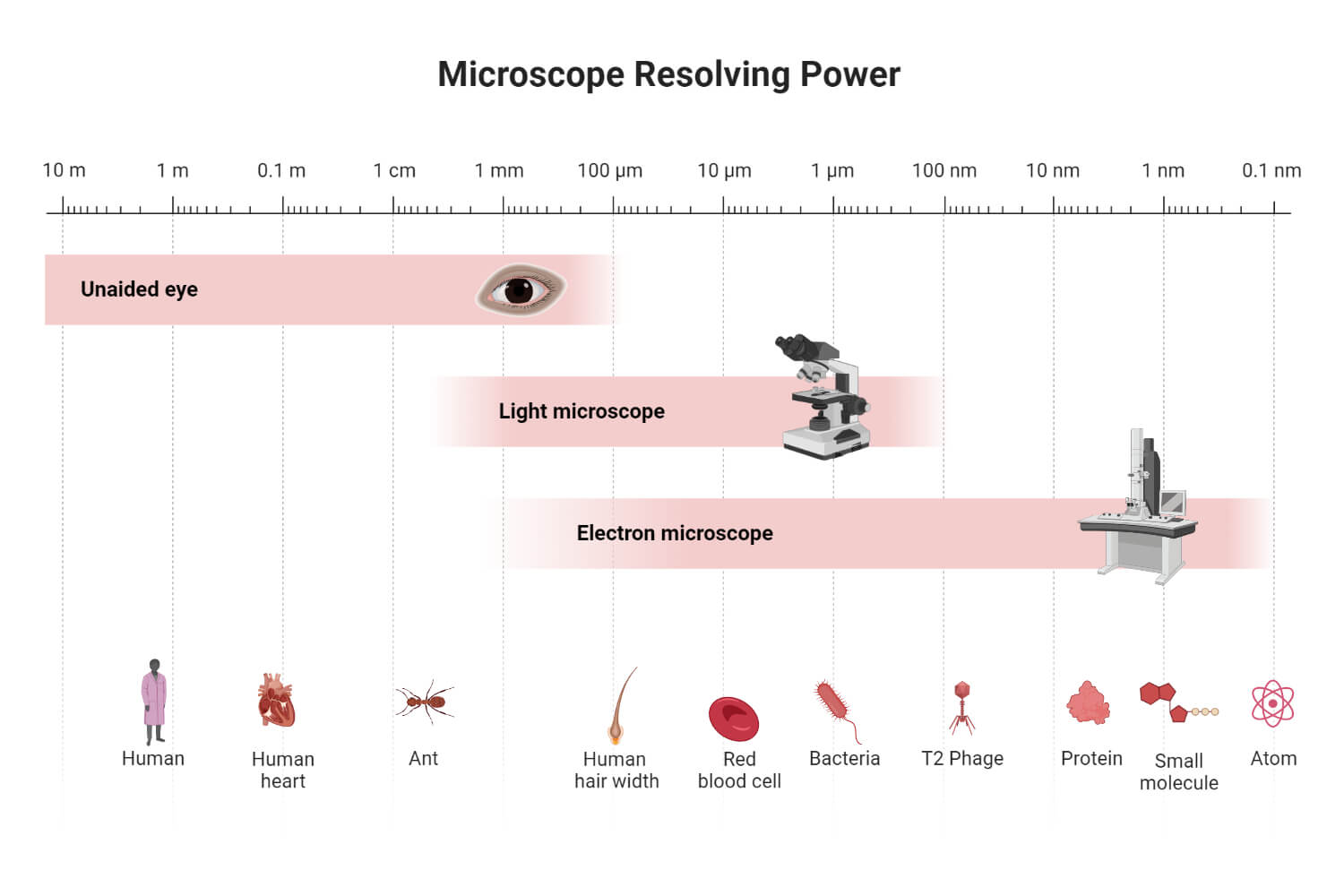
Parts of Simple Microscope
Mechanical Components
The mechanical parts are associated with holding the specimen, supporting the microscope, and regulating some of the functions of the microscope.
Metal Base: It gives the microscope its foundational support
Stage: The flat platform is used to hold the slides for inspection.
Stage Clips: The slides are held securely in place by stage clips.
Coarse adjustment knob: The low power lens is typically employed to allow the tube movement and used for initially scanning objects with focus.
Arm/Pillar: It is made of metal and connects to the base of the microscope and supports the tube of the microscope.
Modern simple microscope also features following mechanical components, namely:
Body Tube: The body tube, sometimes known as a tube, is what joins the eyepiece and the objective lenses.
Resolving nosepiece: It is also referred to as the Turret. The various objective lenses have holders on the resolving nosepiece which facilitate rotation of these lenses. All contemporary simple and compound microscopes use this nosepiece, which is a common component.
Substage: The substage is located directly beneath the stage. This contains an integrated aperture diaphragm.
Fine adjustment knob: It focuses the image with the high-powered lens by moving the body tube in the presence of oil. A simple microscope usually does not have this feature, however more recent simple microscopes do.
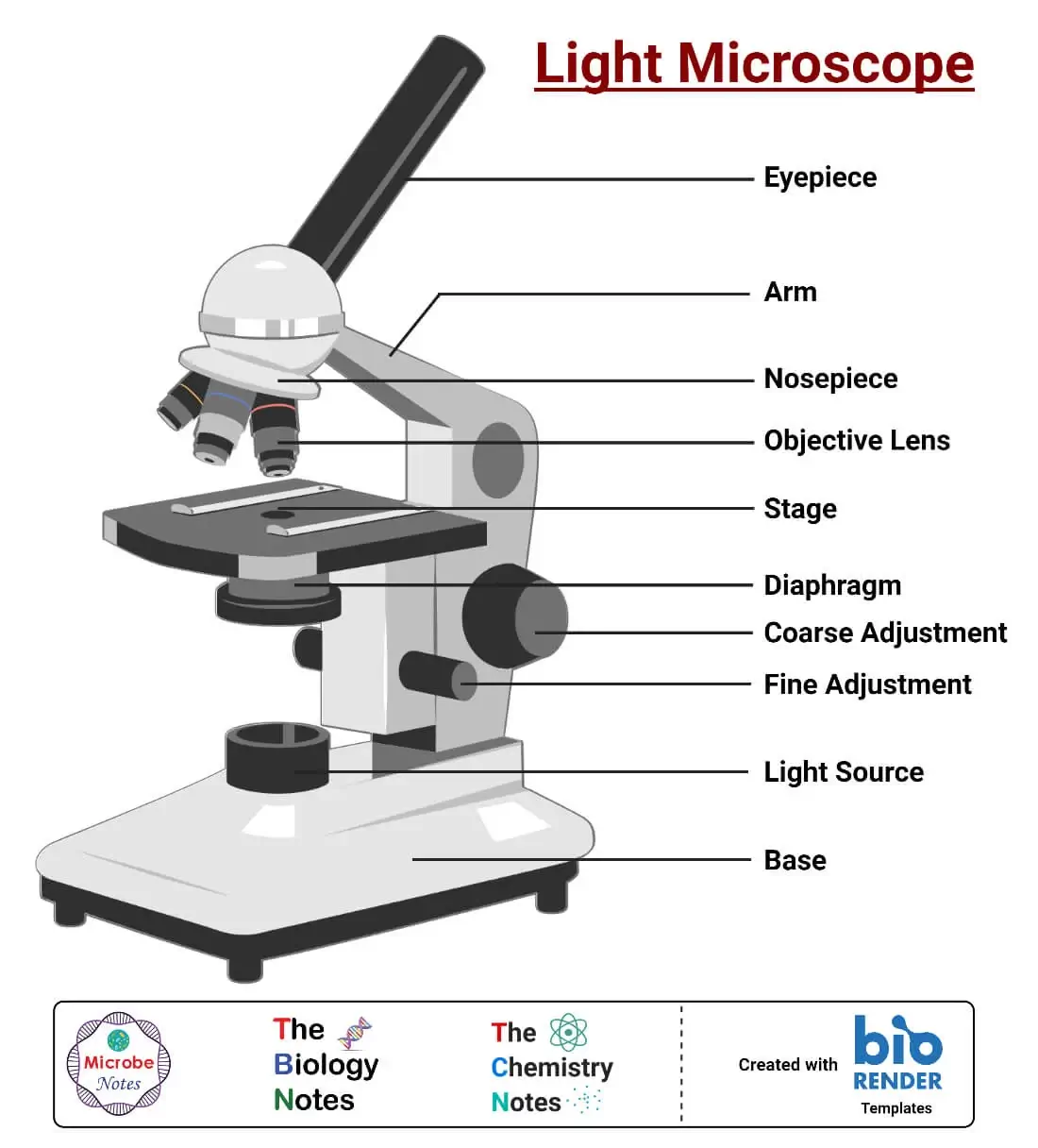
Optical Components
The optical components aid in specimen magnification and visualization. These elements make up this part:
Mirror: A plano-concave reflecting type of mirror is present below the stage using a frame, and it aids in concentrating ambient light on the subject being examined. Additionally, modern basic microscopes contain a movable light source that can be used to direct light onto the specimen.
Lens/Eyepiece: Simpler microscopes from earlier generations used the lens as an eyepiece to observe the sample. It employs a biconvex lens for the magnification of image which can be rotated while being examined. However, contemporary microscopes use a mix of objective lenses with various magnification levels to achieve various levels of image magnification. The lens’ magnification ranges from 10x to 15x.
Objective Lens: A conventional microscope has just one lens, but modern basic microscopes also use an array of objective lenses to provide different levels of magnification. These have magnifications of 10x, 40x, and 100x and are attached to the nosepiece.
Operating Procedure of Simple Microscope
The following points detail the process of working with conventional simple microscopes:
- Place the microscope on the comfortable place which has access to natural light.
- Clean the microscope lens thoroughly with lens tissue or lens cloth
- Prepare the slide, cover the specimen with a cover slip, place it on the stage and secure the slide with stage clips.
- Adjust the focus with adjustment screw i.e., coarse adjustment knob and begin observing the specimen by switching through low power lens to high power lens to view the image.
Applications of Simple Microscope
- It is used when researching the microscopic characteristics of fibres.
- It is employed to magnify tiny components of watches, mobile phones, etc.
- It is used in microbiology to investigate tiny organisms including diatoms, algae and fungi.
- It is used by dermatologists to research skin diseases.
- It is utilized to investigate biological samples like hair, blood, skin, nails, etc.
- It is used during crime scene investigations to separate, distinguish, and compare forensic materials.
- Watchmakers frequently use it to magnify a small portion of the timepiece.
- Jewelry makers can see a magnified image of the small components of the jewelry by using a simple microscope.
Advantages of Simple Microscope
- These are inexpensive and affordable.
- The microscope is simple to set up and operate thus, little expertise is required.
- It employs natural light as the light source.
Limitations of Simple Microscope
- In comparison to other types of recently used microscopes, the resolution of the virtual image produced by a simple microscope is lower.
- Relatively low magnification is achieved compared to compound eyepiece since only one lens is used. Certain details are missed any time an individual magnifies something.
- The entire magnification is confined to only a single lens.
Precautions
- Cover your microscope when not in use.
- It is best to hold a microscope with both hands. Take hold of the arm with one hand and support it with the other hand by placing it beneath the base.
- Avoid using your fingers to touch the glass portion of the lenses. Specialized lens paper is preferred to clean the lens.
Examples of Simple Microscope
MC510 – Elementary Microscope (Narang Medical Ltd.)
- It is portable, lightweight, and easy to use while still possessing characteristics of a compound microscope. Precision Optical Glass Lenses and metal components are designed for years of dependable performance.
- Straight fixed tube monocular observation.
- Stage: Fixed square stage with stage clips, measuring 75 x 85 mm.
- Plano-Concave mirror diameter 25mm fitted on gimble mount for illumination.
- Achromatic 10X objectives
- 10X and 15X Huygenian eyepieces.
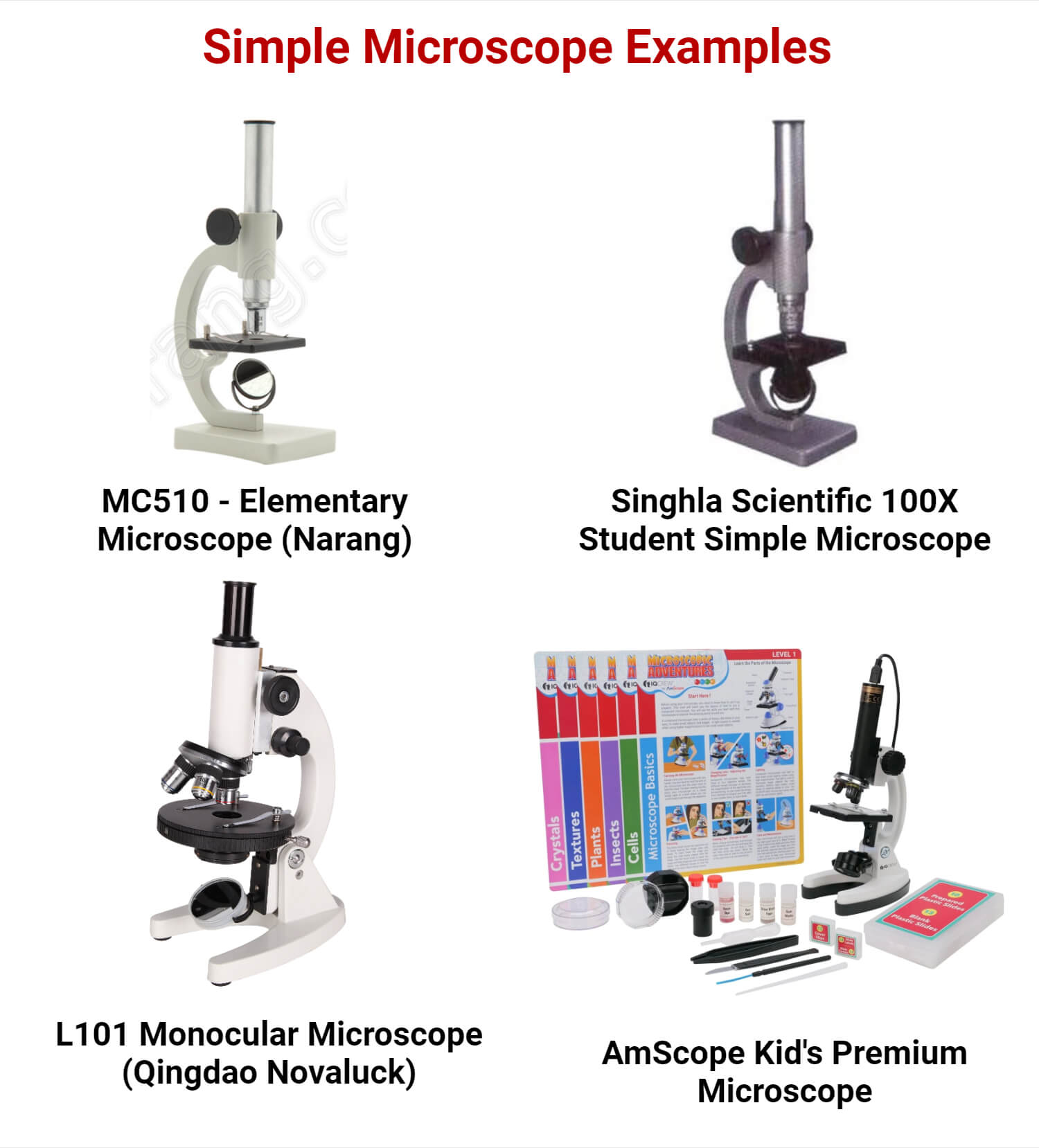
Simple Microscope (Singhla Scientific Industries)
- Fixed stage 75×85 mm, mechanical tube length 160 mm.
- Rack and pinion movement.
- Stage clips for all specimens and slides.
- 100x magnification is achieved with the help of a 10-x Huygenian eyepiece and 10-x objective.
- Built entirely out of metal.
- Mirror, plano concave, 38 mm diameter.
Student Laboratory Biological Monocular Simple Microscope L101 (Qingdao Novaluck Supplies Co. Ltd.)
- Monocular head with eyepiece of magnification 5x,10X, and 15x.
- Achromatic objective which can magnify by 5x, 10x and 45x.
- 25x to 675x in total magnification.
- Stage is round with slide clips of dimensions 90*90mm
- Triple nosepiece and rotating disc diaphragm condenser
- Plano-concave mirror for illumination
References
- https://www.researchgate.net/publication/328578142_COMPONENTS_OF_A_MICROSCOPE_AND_ITS_FUNCTIONS
- https://www.britannica.com/technology/microscope/Magnification
- https://school.careers360.com/physics/simple-microscope-topic-pge
- https://www2.mrc-lmb.cam.ac.uk/microscopes4schools/microscopes2.php
- https://www.opticsplanet.com/howto/how-to-use-your-first-microscope.html
- https://www.narang.com/laboratory-products/simple-microscopes/index.php
- https://www.polylabindia.com/simple-microscope-1462358.html
- https://novaluck.en.made-in-china.com/product/bOIGRcquLdkh/China-Student-Laboratory-Biological-Monocular-Simple-Microscope-L101.html

Thanks!
mirror in simple microscope is plano convex or concave
Thanks for the correction. It should be a plano concave mirror. We have updated the article.
Great information to me
Thank you
Essay on simple microscope 🙏
10 marks
All topics are very helpful for me but please I have to request u can u please give me biostatistics notes? If possible
it’s quite ok
I was hoping for the simpler one,
Where can i get it?
Itz bit helpful to me